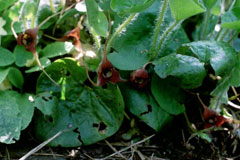 |
|
(c) 2010 Ken Fern & Plants For A Future |
 |
| (c) 2010 Ken Fern & Plants For A Future |
Translate this page:
Summary
Bloom Color: Red.
Main Bloom Time: Mid spring. Form: Irregular or sprawling, Spreading or horizontal.
Physical Characteristics

 Asarum caudatum is an evergreen Perennial growing to 0.1 m (0ft 4in) by 0.3 m (1ft) at a fast rate.
Asarum caudatum is an evergreen Perennial growing to 0.1 m (0ft 4in) by 0.3 m (1ft) at a fast rate.
See above for USDA hardiness. It is hardy to UK zone 7. It is in leaf all year, in flower from July to August. The species is hermaphrodite (has both male and female organs) and is pollinated by Flies.
Suitable for: light (sandy), medium (loamy) and heavy (clay) soils and prefers well-drained soil. Suitable pH: mildly acid and neutral soils. It can grow in full shade (deep woodland) or semi-shade (light woodland). It prefers moist soil.
UK Hardiness Map
US Hardiness Map
Synonyms
Plant Habitats
Woodland Garden Dappled Shade; Shady Edge; not Deep Shade; Ground Cover;
Edible Uses
Edible Parts:
Edible Uses: Condiment Tea
The root can be used as a ginger substitute[183]. The root has a pungent, aromatic smell like mild pepper and ginger mixed, but more strongly aromatic. It can be harvested all year round, but is best in the autumn[K]. It can also be dried for later use[K]. Leaves are a tea substitute[177, 183].
References More on Edible Uses
Medicinal Uses
Plants For A Future can not take any responsibility for any adverse effects from the use of plants. Always seek advice from a professional before using a plant medicinally.
Analgesic Antirheumatic Appetizer Laxative Poultice Stomachic Tonic
The root is laxative, stomachic and tonic[61, 257]. A tea made from the root is used in the treatment of colds, colic, indigestion and stomach pains[213, 257]. The root is harvested in the autumn and dried for later use[238]. The whole plant is analgesic, antirheumatic, appetizer and tonic[257]. A decoction is used externally to treat headaches, intestinal pain and knee pains[257]. A poultice made from the heated leaves is applied to boils, skin infections and toothaches, whilst a decoction of the leaves is used as a wash on sores[257].
References More on Medicinal Uses
The Bookshop: Edible Plant Books
Our Latest books on Perennial Plants For Food Forests and Permaculture Gardens in paperback or digital formats.

Edible Tropical Plants
Food Forest Plants for Hotter Conditions: 250+ Plants For Tropical Food Forests & Permaculture Gardens.
More

Edible Temperate Plants
Plants for Your Food Forest: 500 Plants for Temperate Food Forests & Permaculture Gardens.
More

More Books
PFAF have eight books available in paperback and digital formats. Browse the shop for more information.
Shop Now
Other Uses
References More on Other Uses
Cultivation details
Landscape Uses:Ground cover, Woodland garden. Prefers a rich moist neutral to acid soil in woodland or a shady position in the rock garden[1, 200]. Plants are hardy to at least -15°c[200]. The flowers are malodorous and are pollinated by flies[200]. Plants often self-sow when growing in a suitable position[200]. Special Features:Attractive foliage, North American native, Fragrant foliage, Inconspicuous flowers or blooms.
References Carbon Farming Information and Carbon Sequestration Information
Temperature Converter
Type a value in the Celsius field to convert the value to Fahrenheit:
Fahrenheit:
The PFAF Bookshop
Plants For A Future have a number of books available in paperback and digital form. Book titles include Edible Plants, Edible Perennials, Edible Trees,Edible Shrubs, Woodland Gardening, and Temperate Food Forest Plants. Our new book is Food Forest Plants For Hotter Conditions (Tropical and Sub-Tropical).
Shop Now
Plant Propagation
Seed - best sown in a cold frame as soon as it is ripe in the summer[134]. Stored seed will require 3 weeks cold stratification and should be sown in late winter[134]. The seed usually germinates in the spring in 1 - 4 or more weeks at 18°c[134]. When large enough to handle, prick the seedlings out into individual pots and grow them on in light shade in the greenhouse for at least their first winter. Plant them out when large enough in late spring. Division in spring or autumn. Plants are slow to increase[200]. It is best to pot the divisions up and keep them in light shade in the greenhouse until they are growing away strongly.
Other Names
If available other names are mentioned here
Native Range
NORTHERN AMERICA: Canada (British Columbia), United States (Idaho (north), Montana (west), Oregon, Washington), United States (California (n. & w.))
Weed Potential
Right plant wrong place. We are currently updating this section.
Please note that a plant may be invasive in one area but may not in your area so it's worth checking.
Conservation Status
IUCN Red List of Threatened Plants Status :

Growth: S = slow M = medium F = fast. Soil: L = light (sandy) M = medium H = heavy (clay). pH: A = acid N = neutral B = basic (alkaline). Shade: F = full shade S = semi-shade N = no shade. Moisture: D = dry M = Moist We = wet Wa = water.
Now available:
Food Forest Plants for Mediterranean Conditions
350+ Perennial Plants For Mediterranean and Drier Food Forests and Permaculture Gardens.
[Paperback and eBook]
This is the third in Plants For A Future's series of plant guides for food forests tailored to
specific climate zones. Following volumes on temperate and tropical ecosystems, this book focuses
on species suited to Mediterranean conditions—regions with hot, dry summers and cool, wet winters,
often facing the added challenge of climate change.
Read More
Expert comment
Author
Lindl.
Botanical References
60200270
Links / References
For a list of references used on this page please go here
Readers comment